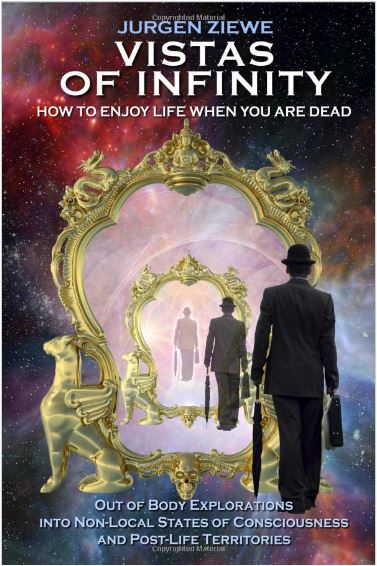 Vistas of Infinity – How to Enjoy Life When You Are Dead by Jurgen Ziewe
Vistas of Infinity – How to Enjoy Life When You Are Dead by Jurgen Ziewe
Reviewed by David Lorimer
Jurgen Ziewe has been meditating and travelling beyond the body for over 40 years by shifting consciousness into nonphysical states of awareness with enhanced lucidity that gives him access to a huge range of afterlife realms in a similar way to Robert Monroe and, in the 18th century, Emanuel Swedenborg. For readers like myself who are familiar with a wide range of literature in this area, the picture that he draws is a consistent one and, as such, represents a further line of convergence in our understanding of what happens after death. He sums up an overriding law as follows: ‘when the relay station and filter, which is our brain, stops functioning, the body is returned to its individual atoms, our conscious and subconscious mind become our new external reality.’ (p. 22) Swedenborg said something very similar whereby the inner becomes the outer. Further on, he defines the afterlife by saying that ‘the place you will live in after you die is a manifestation of your inner life.’
Towards the end of the book, Ziewe reiterates this point by saying that our physical nervous system acts like a shield to block out the subtle movements of energy that we put out. When the shield is gone at death, we are suddenly confronted with ourselves and our output (see also my review of Anne Geraghty below). Everything we see will be a clear mirror of what we are: ‘we will not only see it, but will feel it intimately too’ as witnessed in the life review. In the course of the book, he gives many illustrations of this fundamental karmic law where we receive back what we have put out, positive and negative. It is generally feasible to work through this process by shedding light on it and orienting oneself in loving service to others. This can initially be complicated by the fact that many people do not realise they have died and are in a space very adjacent to our physical vibration and manifestation. He relates the development of his mother and the reconstitution of her appearance as a young woman, while also encountering his father and various other relatives in what he calls a continuum of consciousness.
An important contemporary lesson can be learned from his perception of the unspeakable suffering in the afterlife of a (misguided) suicide bomber. Ziewe describes how the person is surrounded by the very real thought forms of his victims and the representation of their pain, and his own understanding ‘that the fate of his victims and the sufferings could never be reversed or erased.‘ However, in all cases the way out is one of love, service and forgiveness. He explains that our actions create an entanglement of energy that is recorded on what he called the greater Consciousness system or cosmic hard drive – all these energy patterns ultimately have to be harmonised according to the law.
In common with other accounts, our powers of creative manifestation in these other worlds are greatly enhanced, but we do have responsibility for how we use these capacities, and cannot separate ourselves from the seeds we have sown. He describes the higher realms as ones of beauty and love also characterised by the feeling of homecoming, the sense that one deeply belongs. A key theme is the overcoming of our sense of separation by the realisation that we cannot truly separate ourselves from Home, Source or unifying Singularity of Consciousness because it constitutes our essence and sustains everything in being. To realise this oneness is awakening, and we are each an individualised centre or anchor of this same oneness in a vast and intricate pattern or network.
Deep meditation is one way of accessing the stillness at the core of our being and attuning ourselves to it. Ziewe sums up two purposes in the universe: ‘one purpose is a limitless expansion and regeneration in new and different permutations of being; the other purpose is a blissful life in service to others.’ It is possible to live from this stillness and oneness with a sense of universal identity and therefore of love and compassion towards all, so his ultimate advice is just this: realise your unity with the whole of life and consciousness, and use your own life as an expression of loving service to others. In this way, actions of love and goodwill become a stepping stone towards higher consciousness, whether here in this life or after death. In the end, it is not so much the intriguing experiences of this eye-opening book that are enlightening, but the lessons drawn from them in terms of how best to live our lives.
